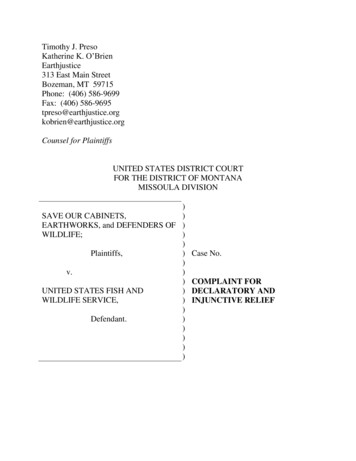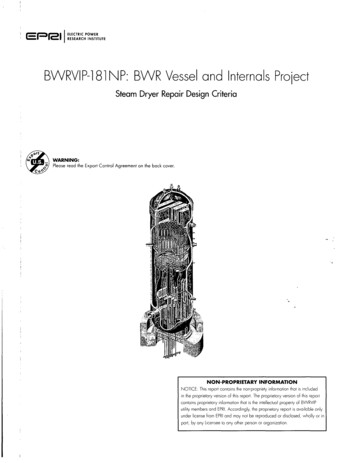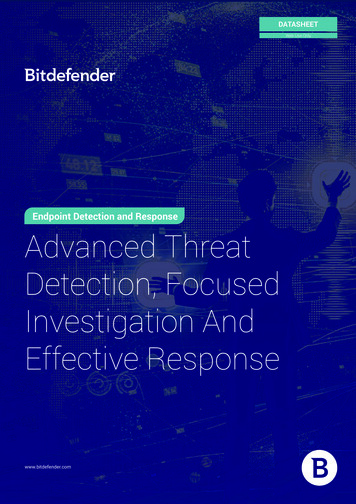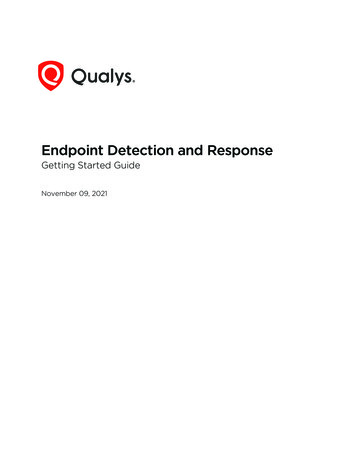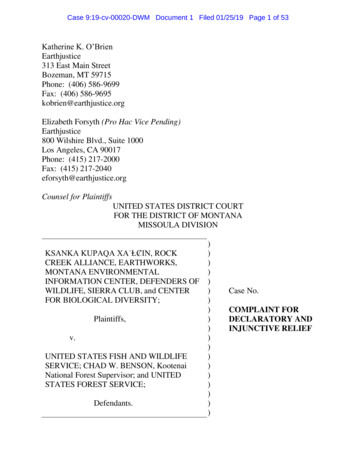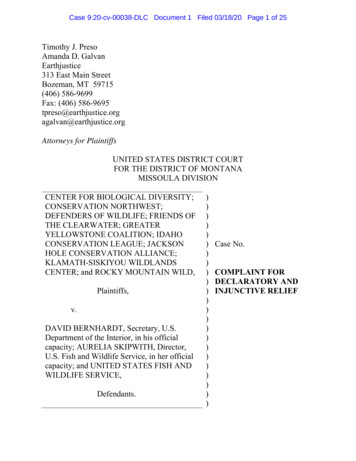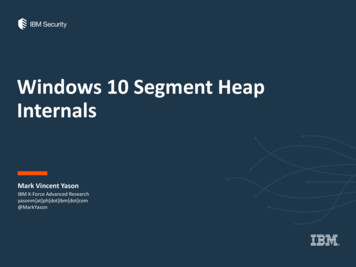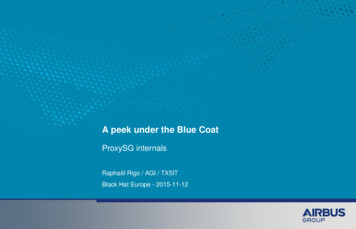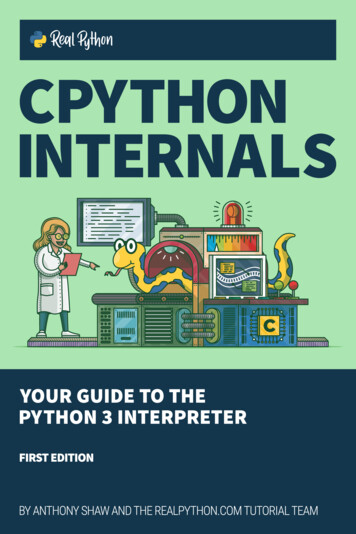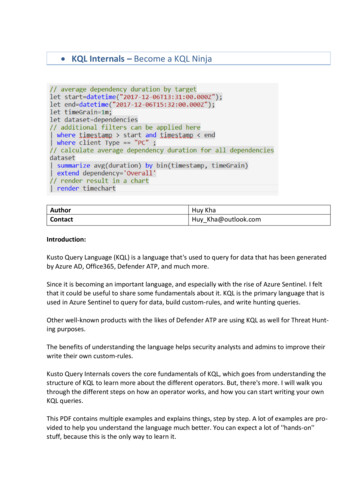
Transcription
EDR InternalsFrom a DefendersPerspectiveFalconForceFIRST CONFERENCE2022
Olaf HartongDefensive Specialist @ FalconForceDetection Engineer and Security ResearcherBuilt and/or led Security Operations CentersThreat hunting, IR and Compromise assessmentsFormer documentary photographerFather of 2 boys“I like warm onforce.nlolafhartong.nl / falconforce.nl
What you can expect from this talkMicrosoft Defender for Endpoint (MDE) capabilitiesWhat kind of telemetry can you work withWhere does it get its telemetry fromAnalyzing its configurationWrap up
CapabilityoutlineWhat can it do for you?
Microsoft Defender for EndpointAll-in-one solution for protecting Windows, Mac and Linux Endpoints Anti-Virus Attack Surface Reduction (ASR) Exploit Guard Application Control (WDAC) EDR Telemetry Incident Response Software Inventory / Vulnerability Management Network Sensor DLPSome parts are also available natively on Windows. Defender for Endpoint integrates these partsinto a combined product and allows for centralized logging and management.
Anti-Virus EngineLeverages existing Microsoft Defender Anti-Virus product. AV events are logged to M365 Defender Portal.Signature-based detection (behavior file characteristics).Cloud-based detections where samples are uploaded to cloud for analysis and can be executedin a sandbox.Great research on the signature database by Camille /master/windows-defender/VDM)
Anti-Virus EngineExclusionsFrequently used by attackers to allow their payload to pass, monitor the registry changes.Process exclusions apply to the children of the listed process.The listed process will still be scanned. Unless this file is added to the file exclusion list.These exclusions apply ONLY for the AV component, features like EDR and ASR still apply.
Anti-Virus EngineCheck what it flags on with DefenderCheckSometimes needs several changes to the source to not get detected eck
Attack Surface Reduction (ASR) rules 16 rules to reduce the attacksurface of Windows. Rules can be enabled anddisabled via Reg keys / GroupPolicy. Can be configured to Block oronly Audit. Events are logged in M365Advanced Hunting c3cf8
Attack Surface Reduction (ASR) rulesThe rules (currently) primarily look for file / path names or commandlines, not signer informationor other unique attributes. This allows an attacker to bypass aster/windows-defender/ASR
Windows Defender Application Control (WDAC)Used to control which drivers and applications are allowed to run, does not require license!Successor to AppLocker, available in Windows 10 and up and Server 2016 Policies can be layered and built to allow on deny based on:The codesigning certificate(s)Attributes in the PE headerReputation in the Microsoft's Intelligent Security GraphThe path from which the app or file is launchedThe parent processThe launching identityExcellent blogs on this by Matt Graeber https://mattifestation.medium.com
EDR TelemetryRelies on a separate Windows Service, exclusive to MDE called ‘Sense’ running via MsSense.exe.Collects relevant data from running system, for example: File Events (File Creation, Deletion). Network Connections. Suspicious API usage such as Reading memory from another process.All events are logged and stored in ‘Advanced Hunting’ tables where they can be queried, andcustom detection rules can be created to detect unwanted behavior.
EDR TelemetryWhich events are logged is controlled and configured by Microsoft. For example: list of registry keys that are monitored is fixed and cannot be extended. Focus on events that change the system.Some events are (heavily) sampled to avoid excessive logging taking place, most notably: Network connections. File writes. Less events are logged from trusted processes (Microsoft-signed). Some events such as reading memory from a remote process are limited to LSASS process.Main data source is Event Tracing for Windows (ETW). Over 65 different providers queried. This includes ‘private’ ETW logs, such as Threat Intelligence.
Data StoragePay per device / user. Includes the storage of generated events. Detailed information available for 30 days. Timeline/condensed data available for 180 days.Longer retention possible by copying data to other solutions such as Azure Dataspaces or AzureSentinel. Should be approximately 15-20MB per device per day.
What kind of data can I build detections on hunt with?
Data xploitGuardChildProcessBlockedAND MUCH, MUCH MORE
Data xploitGuardChildProcessBlockedAND MUCH, MUCH MORE
Snatch them from the portalaz login --use-device-code -t [TENANTNAME]az account get-access-token curl -v -H "Authorization: Bearer AZURE TOKEN" -H 'Content-Type:application/json' ion/DeviceEvents"
Snatch them from the portalaz login --use-device-code -t [TENANTNAME]az account get-access-token curl -v -H "Authorization: Bearer AZURE TOKEN" -H 'Content-Type:application/json' ion/DeviceEvents"
MDE default alert coverageSlide removed TLP:Amber
MDE telemetry potential mapping to MITRE ATT&CK
MDE telemetry potential mapping to MITRE ATT&CK
Data potential for 299 techniques
Visualizing relationships
Where does itget itstelemetry?This is important to understand bypassand tampering opportunities as well aspossible blind spots.
Kernel CallbacksThe kernel's callback mechanism provides a general way for drivers to request and providenotification when certain conditions are satisfied.
Kernel Callbacks
Event Tracing for WindowsEvent Tracing for Windows (ETW) provides a mechanism to trace and log events that are raisedby user-mode applications and kernel-mode drivers.ETW is implemented in the Windows operating system and provides a fast, reliable, and versatileset of event tracing features. Its architecture consists of three layers;Event providersEvent consumersEvent tracing sessionsGreat reference material by Matt tracelogging-e465f8b653f7
MsSense.exe ETW ProvidersMsSense is one of the core components of MDE that routes the telemetry which it gathers inits own set of providers.Curious about the traces it utilizes I had a look at the trace logging metadata with a scriptcreated by Matt ac1614694886c8ef4583149f53658
MsSense.exe ETW dataThe traced events are stored into a SQLite database in a protected folder on the file system. Thetable name used is AsimovEvents.Asimov was the code name in 2014 for the Unified Telemetry Client, which is now deprecatedand is replaced by the DiagTrack agent.On regular intervals the contents of the database gets uploaded and the data gets flushed.
Tracing these providersCurious to see what these providers contained I firedup Sealighter to trace these file to a file.Sealighter is highly configurable and can subscribe tomultiple providers at once, user and kernel traces.Outputs to Stdout, JSON file, or Windows Event ly built for research, if you want to use customETW events for monitoring SilkETW is probably moresuited.
Sample traceBase64?
Base 64 decode
What is the binary jibberish?The data is serialized with Bond.Bond is a cross-platform framework for working with schematized data. It supports crosslanguage de/serialization and powerful generic mechanisms for efficiently manipulating data.Bond is broadly used at Microsoft in most of their services.So far I have not found the schema’s for these streams.Next question is where is that data coming from, it clearly looks like PowerShell event logging.https://github.com/microsoft/bond
Where is the data coming from?No direct subscription for anything other than the EventLog serviceSo is MDE also making use of the regular Sourcerer
DiagTrackMDE piggybacks of the Diagtrack service to get most of the ETW event telemetry. This serviceuses the DiagTrack-Listener subscription. MDE is not subscribing to all these providers itself.By default, only Local Administrators, Performance Log Users, and services running asLocalSystem, LocalService, NetworkService can control trace sessions and consume event data.Since MDE uses the MsSense service, which runs as System this is fine.Looking into this service I learnt this service is not protected. When you stop the DiagTrackservice, there is no telemetry sent to the cloud anymore.
Configuration
MDE ConfigurationLike any product MDE also requires a configuration to know what to log.This configuration is maintained by Microsoft and is downloaded from theinternet on a regular basis.It is stored on the box, in a non-clear text format.Additionally it is signed and not easily tampered with.The exact details are up to you to find out ;) (sorry, not sorry)
Configuration item examplesTelemetry sources (ETW providers, Registry Keys etc.)Exclusions and Filters (for example; extensions, process names, certificate signatures)Capping (global and per event distinct field combination)Dynamic data collectionAgent configurationQuotas (volumetric per time period)
Configuration stats 70k lines of JSON 65 ETW Providers utilized 500 registry paths monitored 60 data collection commands that fire frequentlyDifferent settings for high latency environmentsElevated child process recording quotas for scripting tools and browsers
Configuration - ETW Providers (a selection)Generic ETW CreateFile PatternMicrosoft-Windows-ThreatIntelligence Very intresting provider, only for osoft-Windows-TCPIPMicrosoft-Windows-WMI-Activity We’ve just seen these eventsPowershell soft-Windows-RPCMicrosoft-Windows-SEC What would this be?SecureETW
SecureETWListed in the configuration with the followingProviderGuid: {54849625-5478-4994-A5BA-3E3B0328C30D}Also known as Microsoft-Windows-Security-Auditing
What does that config look like? some SID filters and much more
So, which other EventIDs is it looking forCurrently, the following Events are traced from the Security log:
Mapping EventIDs to name and Audit tent cryptographic key operation.Persistent cryptographic key export.Taking Ownership on File from TrustedInstallerTaking Ownership on MDE KeyHardlink Create Audit EventSense tampering through object sacl changeA service was installedLogon eventAn account failed to log onA scheduled task was createdA scheduled task was deletedA scheduled task was updatedA user account was createdPlug and Play eventFirewall service startedFirewall service stoppedFirewall app blocked from listeningFirewall has blocked a connection outboundFirewall has blocked a connection inboundCredman - Credentials BackupCredman - Read CredentialsVault Credential - Find CredentialVault Credential - Enumerate CredentialsSystemSystemPolicy ChangePolicy ChangeObject AccessPolicy ChangeSystemLogon/LogoffLogon/LogoffObject AccessObject AccessObject AccessAccount ManagementDetailed TrackingSystemSystemObject AccessObject AccessObject AccessAccount r System EventsOther System EventsAuthorization Policy ChangeAuthorization Policy ChangeFile SystemAudit Policy ChangeSecurity System ExtensionLogonLogonOther Object Access EventsOther Object Access EventsOther Object Access EventsUser Account ManagementPlug and Play EventsOther System EventsOther System EventsFiltering Platform ConnectionFiltering Platform ConnectionFiltering Platform ConnectionUser Account ManagementOther Logon/Logoff EventsOther Logon/Logoff EventsOther Logon/Logoff Events5382464847194724Vault Credential - Get Unique CredentialLogon using explicit credentialsSystem Audit Policy was changedAn Attempt was made to reset an account passwordLogon/LogoffLogon/LogoffPolicy ChangeAccount ManagementOther Logon/Logoff EventsLogonAudit Policy ChangeUser Account Management47264732A user account was deletedA member was added to a security-enabled local groupAccount ManagementAccount ManagementUser Account ManagementSecurity Group Management473147264733473447384732Local group createdA user account was deletedLocal group removedLocal group deletedA user account was changedA member was added to a security-enabled local urity Group ManagementUser Account ManagementSecurity Group ManagementSecurity Group ManagementUser Account ManagementSecurity Group Management64234798Forbidden installation (PNP Audit)User's local group membership was enumeratedDetailed TrackingAccount ManagementPlug and Play EventsUser Account Management4799Security-enabled local group membership was enumeratedAccount ManagementSecurity Group ManagementManagement
Microsoft Audit Policy settingsAudit policy settings determine whether the operating system generates audit events whencertain tasks are performed.These settings can be configured on 4 levels:No Auditing ( 0 )Success ( 1 )Failure ( 2 )Success and Failure ( 3 olicies
Are all these events available on all her Logon/Logoff EventsLogonAudit Policy ChangeUser Account Management21130311FALSETRUETRUEFALSEAccount ManagementAccount ManagementUser Account ManagementSecurity Group Management1111TRUETRUELocal group createdA user account was deletedLocal group removedLocal group deletedA user account was changedA member was added to a security-enabled local urity Group ManagementUser Account ManagementSecurity Group ManagementSecurity Group ManagementUser Account ManagementSecurity Group 4798Forbidden installation (PNP Audit)User's local group membership was enumeratedDetailed TrackingAccount ManagementPlug and Play EventsUser Account Management1101FALSETRUE4799Security-enabled local group membership was enumerated Account ManagementSecurity Group 81Persistent cryptographic key operation.Persistent cryptographic key export.Taking Ownership on File from TrustedInstallerTaking Ownership on MDE KeyHardlink Create Audit EventSense tampering through object sacl changeA service was installedLogon eventAn account failed to log onA scheduled task was createdA scheduled task was deletedA scheduled task was updatedA user account was createdPlug and Play eventFirewall service startedFirewall service stoppedFirewall app blocked from listeningFirewall has blocked a connection outboundFirewall has blocked a connection inboundCredman - Credentials BackupCredman - Read CredentialsVault Credential - Find CredentialVault Credential - Enumerate CredentialsSystemSystemPolicy ChangePolicy ChangeObject AccessPolicy ChangeSystemLogon/LogoffLogon/LogoffObject AccessObject AccessObject AccessAccount ManagementDetailed TrackingSystemSystemObject AccessObject AccessObject AccessAccount r System EventsOther System EventsAuthorization Policy ChangeAuthorization Policy ChangeFile SystemAudit Policy ChangeSecurity System ExtensionLogonLogonOther Object Access EventsOther Object Access EventsOther Object Access EventsUser Account ManagementPlug and Play EventsOther System EventsOther System EventsFiltering Platform ConnectionFiltering Platform ConnectionFiltering Platform ConnectionUser Account ManagementOther Logon/Logoff EventsOther Logon/Logoff EventsOther Logon/Logoff Events5382464847194724Vault Credential - Get Unique CredentialLogon using explicit credentialsSystem Audit Policy was changedAn Attempt was made to reset an account passwordLogon/LogoffLogon/LogoffPolicy ChangeAccount Management47264732A user account was deletedA member was added to a security-enabled local anagementManagementManagementManagement
So, we seem to be having some blind spotsFortunately, the MDE team tries to help you a bit here.They’ll enable some of the settings when you install the 1575157537953805381538247246423MDE-NameTaking Ownership on File from TrustedInstallerTaking Ownership on MDE KeyHardlink Create Audit EventA service was installedA scheduled task was createdA scheduled task was deletedA scheduled task was updatedPlug and Play eventFirewall app blocked from listeningFirewall has blocked a connection outboundFirewall has blocked a connection inboundCredman - Read CredentialsVault Credential - Find CredentialVault Credential - Enumerate CredentialsVault Credential - Get Unique CredentialAn Attempt was made to reset an account passwordForbidden installation (PNP Audit)AuditCategoryPolicy ChangePolicy ChangeObject AccessSystemObject AccessObject AccessObject AccessDetailed TrackingObject AccessObject AccessObject goffAccount ManagementDetailed TrackingAuditSubCategoryAuthorization Policy ChangeAuthorization Policy ChangeFile SystemSecurity System ExtensionOther Object Access EventsOther Object Access EventsOther Object Access EventsPlug and Play EventsFiltering Platform ConnectionFiltering Platform ConnectionFiltering Platform ConnectionOther Logon/Logoff EventsOther Logon/Logoff EventsOther Logon/Logoff EventsOther Logon/Logoff EventsUser Account ManagementPlug and Play 00000000000000010Win10 LSEFALSETRUETRUE
So, we seem to be having some possible blind spotsHowever, the categories that are producing a larger volume of telemetry areuntouched to not interfere with the log ingestion volume on your SIEM.These settings are not documented in the MDE documentation and might beoverwritten by Group Policy settings.Make sure to check your GPOs and enable the events you care about.Otherwise there will be no telemetry AND no alerts on these events.
PowerShell script to check your environmentI’ve created an ugly script to check allyour GPOs are set properly.Obviously some are layered so make sureto check that too.The script relies on the Remote ServerAdministration Tools (RSAT).It’s available on my ck
Wrapping upKnow your tools, understand their strengths and weaknessesUnderstand what your tools are detecting and HOW they are detecting itContinuously reassess this to see what is new or improvedAugment the weak or blind spots with additional tools
Thank you! Questions rtong
Wait, there ismore Bonus content .
Sysmon vsMDE
Pros and cons per solutionMDESysmon Full control over the config and the datayou’ll get Fully maintained by Microsoft (configand ingestion) Best applied to augment MDE or in fullparallel Detection and Response capability,custom detections possible in addition Rich and unsampled telemetry Rich set of telemetry, way more thanSysmon- You must maintain it yourself (config,ingestion and detections)- Only detection, no response- The configuration is non-configurable- Telemetry is sampled for most 5663b10347
Sysmon vs MDE telemetrySysmon ID Sysmon Event Name1Process CreationProcess Changed a file creation2timeMDE an/a3Network Connection4567Sysmon Service State ChangeProcess TerminatedDriver LoadedImage ventsDriverLoadDeviceImageLoadEvents ImageLoaded8Create Remote ThreadDeviceEventsCreateRemoteThreadApiCall9Raw File Access Readn/a10Process AccessDeviceEvents11File CreateDeviceFileEvents12Registry Create and DeleteDeviceRegistryEvents1314151617181920Registry Value SetRegistry Key and Value RenameFile Create Stream HashSysmon Config ChangePipe Event CreatedPipe Event ConnectedWMI EventFilter activityWMI EventConsumer activityWMI EventConsumerToFilteractivityDNS QueryFileDeleteClipboardChangeProcess ileDeletedn/an/aFileDeleted212223242526Notes on MDEHeavily sampled, only 1st seen eventNo signer information only hashesHeavily sampledMissing info compared to unctionONLY logged for the lsass.exe process.It does provide TotalBytesCopied on ReadProcessMemoryApiCall.On OpenProcessApiCall is supplies the DesiredAccess in decimalvaluesFilters are appliedFilters are appliedSeems to be there in MDE but often unpopulatedOnly first seen event, connect or createResponse to successful queriesNo exposed telemetry, it does have alerts for itNo file retention option
Sysmon vs MDE – features / telemetrySysmon - UniqueClipboard events savingDeleted files savingPreserve deleted PE filesPreserve files for configured processesPreserve files with configured extensionsPreserve files for configured SIDsMDE - ocessMemory . 181 in total
MDE telemetry potential mapping to MITRE ATT&CK
Sysmon telemetry potential mapping to MITRE ATT&CK
4697 A service was installed System Security System Extension 1 0 FALSE 4624 Logon event Logon/Logoff Logon 1 3 TRUE 4625 An account failed to log on Logon/Logoff Logon 2 3 TRUE 4698 A scheduled task was created Object Access Other Object Access Events 1 0 FALSE 4699 A scheduled task was deleted Object Access Other Object Access Events 1 0 FALSE
